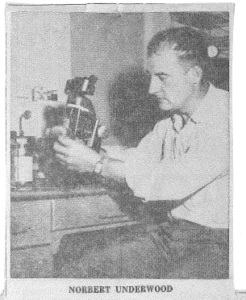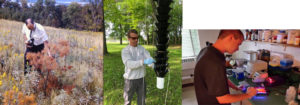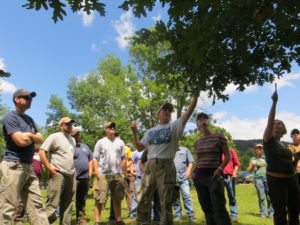By Andrea Diss Torrance, invasive insects program coordinator, andrea.disstorrance@wisconsin.gov, 608-516-2223 and Bill McNee, forest health specialist, Oshkosh, Bill.Mcnee@wisconsin.gov, 920-360-0942
Wisconsin has a long history of forestry management, with a state program beginning in 1904 that later expanded in 1949 to include the survey and management of forest pests. The first state forest entomologist, Norbert Underwood, was hired that year. Nearly ten years later, Mr. Underwood was joined by a forest health program coordinator and three additional forest entomologists. The entomologists were based in Spooner, Antigo, Oshkosh and Black River Falls, while the coordinator, and later a pathologist, were stationed at the forest health lab in Fitchburg.

First state forest entomologist, Norbert Underwood, was hired in 1949.
Over the years, the forest health program has expanded in scope to address evolving needs of the state’s forest resource. Staff based in field offices were cross trained in entomology, pathology and invasive forest plants so they could be references for foresters and other stakeholders in their regions. Today, forest health staff continue to monitor a wide range of forest health issues, including insects and diseases as well as invasive plants, climate change and severe weather. The program has also added staff focused on invasive worms, laboratory identification, and education and outreach. While the forest health program has evolved over the years, the mission has always been the same: assist foresters, industry and woodland owners in maintaining healthy and productive forests.

Methods of detecting forest health issues include field visits (historical photo shown on left), trapping (middle) and genetic sequencing (right).
Responding to invasive pests and diseases has always been a big part of the forest health program, and in recent years, the program has also expanded into the detection and management of invasive forest plants. Keep reading for a few highlights of forest health management in Wisconsin:
- In the 1950’s forest health staff detected and tracked European elm bark beetle, a carrier of Dutch elm disease (DED), across the state. Program staff also provided recommendations for elm management in urban and riverine forests where DED had killed the dominant elm trees.
- In the 1990’s, forest health program entomologists cooperated with those from the Department of Agriculture, Trade and Consumer Protection (DATCP) to delimit populations of gypsy moth that had been detected along the Lake Michigan shoreline. The two agencies collaborated to reduce the spread of this invasive pest by implementing trapping and aerial treatment programs. Since then, the gypsy moth control efforts have expanded to include a state-facilitated aerial spray program for communities and landowners, cost-sharing for suppression treatments, and outreach and education on control and management through a multi-agency WI gypsy moth portal.
- When emerald ash borer (EAB) was found in Wisconsin in 2008, the DNR forest health program, DATCP and other state and federal agencies replicated the relationship they had developed when tackling the invasive gypsy moth. Using lessons learned and resources available to each, the agencies divvied up the responsibilities to provide comprehensive guidance and management of EAB in Wisconsin.
- Invasive plants have become an increasing problem with particularly negative impacts on forest regeneration. The forest health program includes invasive forest plant specialists who have met this challenge by developing policy and best management recommendations, implementing education and outreach programs for various groups, and relationship-building with DATCP nursery inspectors to intercept regulated invasive plants.

Forest health specialist offering a training class to foresters. Outreach and education are an important component of maintaining and enhancing forest health in Wisconsin.
While the pests, diseases and other threats change, the flexible and cooperative approach of the forest health program remains a productive constant. Learn more about forest health issues in Wisconsin on the DNR forest health webpage.
#NASF100
